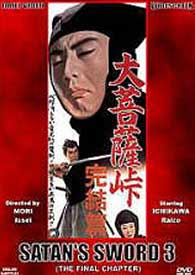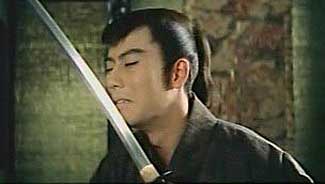 The first two films of three in the Satan's Sword saga were directed by Kenji Misumi who had trained under one of Japan's great jidai-geki directors, Teinosuke Kinugasa, who had been around since the silent era. He is most recognized in the west for Kurutta Ippeji (A Page of Madness, 1926) & Jigokumon (Gate of Hell, 1953), & Kon Ichikawa refilmed Kinugasa's script for the classic Yukinojo henge (An Actor's Revenge, 1963).
The first two films of three in the Satan's Sword saga were directed by Kenji Misumi who had trained under one of Japan's great jidai-geki directors, Teinosuke Kinugasa, who had been around since the silent era. He is most recognized in the west for Kurutta Ippeji (A Page of Madness, 1926) & Jigokumon (Gate of Hell, 1953), & Kon Ichikawa refilmed Kinugasa's script for the classic Yukinojo henge (An Actor's Revenge, 1963).
Kinugasa directed & generally wrote a lot of period films including supernatural samurai tails, & late in his life was responsible for such shockingly good if too often unsung films as Yoso (Priest & Empress, 1963), Okoto to Saskuke (Okoto & Sasuke, 1961). Misumi worked from a script by Kinugasa.
But for Part Three, Satan's Sword: The Final Chapter (Daibosatsu toge: Kenketsu-han, 1961), Kenji Misumi was taken off the project for reasons not known but probably because he was bogged down on a gigantic film project Shaka (Buddha, 1961) in which the studio was placing a lot of expectation.
Still working from the Teinosuke Kinugasa's script, director Kazuo (Issei) Mori had a slightly different tone for the final chapter. Typical of Kazuo Mori's lighter touch is a speed-walking contest between the thief Shichibei the uncle of Otama & a fellow traveller. Kazuo Mori lends The Final Chapter an overall greater vibrancy of lighting & color, lessening the gloominess of Misumi's vision which better understood Kinugasa's tendency to gloom.
That is not to say Kazuo Mori made an inferior conclusion. It's a great film, but definitely of a different tone. Even Hyoma's hairstyle becomes jauntier & sometimes the look of the film is closer to the brightly lit Singing Samurai family epics over at Toei Studios. But the content remains doomful.
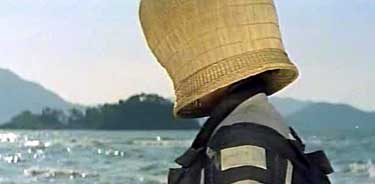 The blind samurai Ryunosuke Tsukue (Raizo Ichikawa) has been staying in a run-down storage house by the sea. He has gained an unexpected reputation for gentleness, though Otama instantly recognizes a coldness in him. The blind samurai Ryunosuke Tsukue (Raizo Ichikawa) has been staying in a run-down storage house by the sea. He has gained an unexpected reputation for gentleness, though Otama instantly recognizes a coldness in him.
Still afflicted by guilt or haunted by spirits of the people he has killed, he dreams of the hideous ghost of Ohama his murdered common-law wife. Resembling a manic depressive, Ryunosuke has throughout the saga gone to the brink of psychosis, then backed off & tried to find some center to himself, only to be drawn back into the darkness by his easy capacity, if not an actual uncontrolable fetish, for killing people.
If previous episodes had not been seen, the beginning of The Final Chapter might lull the viewer into believing Ryunosuke is a good guy at heart, though by the end he'll be as close to a gibbering madman as anyone can get & still able to feed himself.
Disguised as a komuso (wandering beggar monk who wears a large incogito hat) & travelling with a dog named Muku, he's harrassed along the road by the rowdy members of a country dojo or fencing school malingering outside their fencing hall. They try to steal his shakuhachi, a large bamboo flute which komuso use to earn alms.
Ryunosuke asks to borrow one of their bokkens (wooden swords) & they are amused that a travelling monk has the nerve to challenge them. They lend him a bokken & prepare to give him a pounding. But he beats the crap out of them, & takes back his shakuhachi.
They'll never know how lucky they were, since Ryunosuke can kill with a wooden sword as easily as with one of steel, & his struggling within himself not to kill merely because it is easy.
Though completely blind, he wanders the Taikodo road showing no sign of his lack of sight. He travels without sword as kumoso were not generally armed, except with the thickly carved bamboo flute that can double as a club. He's making every effort not to be the monster he has been in the past.
He is trying to grow as the great swordsman Shimada had taught him to "study the soul" before his swordsmanship can be meaningful. When Ryunosuke hears that Shimada has been murdered -- poisoned since no one could've done it in fair fight -- he's inconsolable.
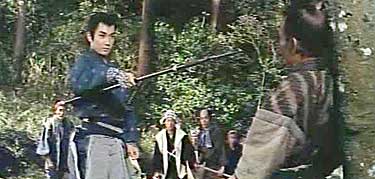 Shichibei the Fleet-footed takes up with another fast-walking wanderer, Hyaku the Eagle-eyes, the man with the Koshu tattoo. Shichibei has been wandering the Tokaido road searching for Ryunosuke. Shichibei the Fleet-footed takes up with another fast-walking wanderer, Hyaku the Eagle-eyes, the man with the Koshu tattoo. Shichibei has been wandering the Tokaido road searching for Ryunosuke.
His niece Omatsu (Fujiko Yamamoto) has had a bumpy life since Ryunosuke killed her grandfather at the beginning of the first film. Even though Shichibei counselled her against the road of vengeance, he is himself the sort of person who likes to get even over injustices.
He has also befriended Hyoma (Kojiro Hongo), the young brother of a man Ryunosuke killed, so Shichibei's plan is to find Ryunosuke & bring Hyoma to kill him, for their mutual vengeance.
Hyaku the Eagle-eyes mistakenly believes he can take the man himself. When Ryunosuke is cornered, Eagle-eyes loses an arm, & Ryunosuke once again falls from a high cliff (as he had done in an earlier installment, so it's a bit redundant here).
He's found at the base of the mountain by a group of women pilgrims, & is soon being nursed back to health by a widow with child.
He lingers at a hotsprings where the widow has suggested his sight might be healed. He doubts it, but welcomes the chance to recouperate & attempt again to recapture his humanity.
He hasn't been chivalrous by nature but humanity requires an effort in that direction. Some minor government official is using his position to shake down the family of young newlyweds. The widow taking care of Ryunosuke runs to get him to come & help, & he says it is not his concern, but she insists. He warns her that such things invariably lead to trouble where he's concerned, but he takes up a yari spear which can double as a blind man's staff, & hurries to intervene with the official's gangsterish scheme.
"I'm blind," he tells them, "but this yari can see you all." They take offense to his interference & force the fight. Five of them die before a gunner stops the battle & arrests Ryunosuke.
They unexpectedly take him to a man who wants to hire him to kill a very young government official. They give him a splendid sword, over which he enthuses weirdly, holding it to his face in an ecstatic slightly loony manner as one would embrace a lover.
The darkness wells up within him anew, & will never again cease to hold him.
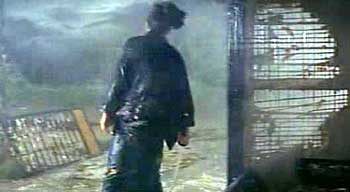 One thing few western viewers understand about this saga is that it really is a spiritual work. One thing few western viewers understand about this saga is that it really is a spiritual work.
No matter how much directors & film studios try to make commercial cinema out of literary works, scriptwriter Kinugasa had a gloomy spiritual bent in all of his films, & he was working from a gigantic serial novel by a Buddhist author, Kaizan Nakazato.
Nakazato purported to have been inspired by the emotive adventurous romanticism of Victor Hugo, & it is interesting to look at such works as Hugo's Les Miserables in the context of Buddhist philosophy of the suffering & illusion of this world, of the sadness of all things.
I've always been of the suspicion that Kaizan was also inspired by Honore de Balzac's linked tales of The Human Comedy, which of course is not comedy at all, but a monumental work with the most agregious moments of horror, deviance, vengeance, love gone awry, warrior excesses, supernaturalism, missed opportunities for peace, & doomful philosophy -- as well as being a work written across the author's life span.
Kaizan Nakazato spent the bulk of his creative life writing this one endless epic tale of the ronin Ryunosuke Tsukue in a tumultuous age struggling against the chaos of the world & the chaos of his own soul. As a devout buddhist it is also Nakazato's great statement on karmic destiny.
He wrote the chapters of the serial originally for newspaper publication beginning in 1913, & for the next three decades wrote cliffhanger segment upon cliffhanger segment, until he died, leaving the so-called "final chapter" as one more cliffhanger.
Speculation has always been that there was to be a conclusion that he did not live to compose, but karmic destiny is something that is worked out not in a single life, but through cycles of reincarnation. I'm not convinced he ever intended a conclusion.
For one thing, Kaizan Nakazato's literary epic never allows the young avenger samurai Hyoma to have even a preliminary encounter with Ryunosuke, as though he never intended them ever to meet, the truer reason for their adventures being other than they themselves might've supposed. Ryunosuke descends into madness as his karma, & Hyoma pursues that madness as his karma, but nothing in their karma permits them actually to meet.
The requirements of action cinema were more direct, however, & the fate of Hyoma & Ryunosuke are shown to be more inextricably linked than Nakazato conveyed. They do eventually meet face to face for the final duel, but by then Ryunosuke is reduced to a gibbering wreck screaming in his perpetual darkness for his lost son.
So even this last chapter is a quest through the shadows of madness with a conclusion as startling as that for Captain Ahab riding off onto the sea upon the white whale, though Ahab's life was by then an illusion as he seemed to wave farewell to his crew, while Ryunosuke's last ride is through the unescaped illusion of passion itself, his mind broken on the wheel of his continuing existence.
copyright © by Paghat the Ratgirl
|
